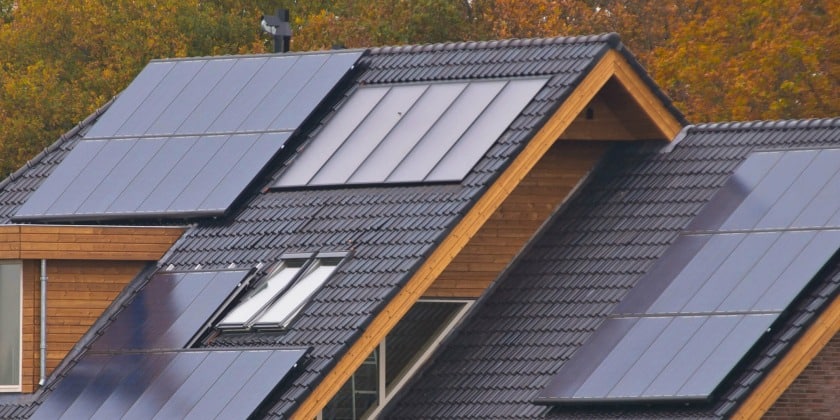Photonic energy is a wave particle that travels at a speed of approximately 300,000 kilometers per second (186,000 miles per second). Almost everything reacts to this energy when contacted by it. The most common reaction is conversion to heat. Plants convert sunlight to chemical energy (complex sugar). The sugar is stored and used by the plant to live and grow.
Humans have also learned how to convert the solar energy to usable energy. We convert solar energy directly into two types of energy for use.
- Solar thermal (heat energy) is used for hot water and steam for power generation.
- Photovoltaic (solar electric) energy is converted from the visible light spectrum to power electrical appliances.
Solar Thermal Energy:
Solar Thermal energy can be used instantly and it can also be stored as hot water or oil in an insulated container. The storage is usually for no more than a day. This is the most efficient conversion of solar energy to usable energy although it may not be the most cost efficient method. Small-scale solar thermal systems require expensive equipment to capture solar energy, convert it to thermal energy and then store it for later use. The net conversion efficiency is around 30% for the average home.
- The cost can be amortized over the lifetime of the system (15 – 20 years). Compared to heating water with electricity, the system reduced energy costs during the system lifetime. Compared to heating water with NG, the system may not reduce energy costs during the system lifetime.
Photovoltaic Energy:
Photovoltaic energy (PV) is used instantly since electricity travels close to the speed of light, although it can be converted and stored as chemical energy. Chemical energy storage such as electrolyte batteries or hydrogen provide 24-hour usage of solar electric energy. It also adds cost to the solar electric energy system. The net conversion efficiency of the average PV system without energy storage is around 13% to 16%. Energy storage will reduce that efficiency to 10% to 14%. Off-grid system net conversion efficiency is under 10%.
- PV systems amortized over 5 to 10 years usually provide a positive return on investment. Over the life of the PV system (25 years), the return is 2x to 5x of the system cost. With energy storage added to the system cost, the lifetime return is 1.5x to 3x of the system cost.
Capacity Limiters for Photovoltaic Energy:
Peak solar hours occur during the six mid-day hours; this is when 80% to 90% of the photon energy is converted to electrical energy. This can be a problem for utilities if electrical energy is consumed during other hours of the day. Utility companies must balance the electrical power grid and provide stable voltage to their customers. A limited amount of solar electric energy can be fed into the electrical grid without causing voltage rise and collapse (around 10% of the electrical load). Increasing the capacity far beyond the 10% limit requires converting the electrical energy to another form of storable energy. Energy storage is necessary to extend the usage of solar electric energy.
- Chemical energy storage (the electrolyte battery) is the most common method where electrical energy can easily be converter to and from chemical energy. The conversion efficiency is around 90% efficient. The cost of chemical energy storage is high, although several types of batteries are now on the market and prices are dropping. Charging the batteries requires hours for most technologies, although some technologies are faster than others. Residential systems are typically used for backup power when the utility power is lost. Commercial systems will use energy storage mostly for load stability and rate cost.
- Hydrogen energy storage (fuel cells) is a growing technology where electrical energy is used to separate hydrogen from a molecule such as water. The conversion efficiency ranges between 60% to 90% depending on the method. The net efficiency is reduced much further if the hydrogen gas is concentrated for storage. Compressed hydrogen is very portable and lightweight. Non-compressed hydrogen would require massive storage space and would be impractical as a stand-alone system.
- A couple of other methods of energy storage are flywheels and capacitor banks but neither have proven to be as feasible as chemical batteries or fuel cells.
Solar Electric Systems:
Solar electric systems produce around 1% of the U.S electrical energy generation; some areas of the U.S are experiencing close to 10%. Here is what is being done to satisfy electric grid stability as solar electric grows in capacity:
- Correcting power factor problems: Most areas of the electrical power grid experience a lagging current because of inductive electrical loads. Solar electric inverters can correct some of that with their capacitors (capacitive loads).
- Peak demand: When too many heavy electrical loads occur at one time, the electrical load demand is high, and very difficult and sometimes expensive to generate and manage. Distributed solar electric generation sites provide onsite power and reduce the peak load demand. Since rain and heavy cloud coverage reduce this capacity, energy storage can be installed to work with the solar electric system to produce power on-demand.
- Load and cost management: Solar electric systems can be directed to produce energy during specific daylight hours when load demand is highest and/or when electrical rates are highest. Combining this with energy storage will increase the return on investment for the system owner.
- Micro-grids and emergency power: Some solar electric systems with energy storage will be designed with extra storage capacity. These systems can operate and produce electrical power for several days or longer.
The applications identified above will allow solar electric system capacity to grow without limits.
Kelly Provence
Solairgen
www.solairgen.com

